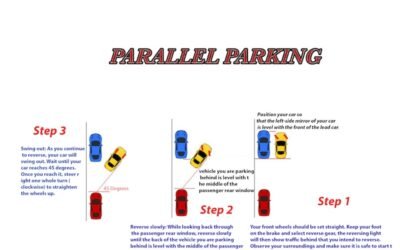Mini roundabouts can be found on test routes for driving tests. They are often used in quieter residential areas in place of T-junctions, to act as a junction and to calm traffic. However, due to their small size, they can be confusing for inexperienced drivers. In this guide, we will provide the correct procedures for driving on mini-roundabouts and the correct rules for drivers and those learning to drive.
Learning Mini Roundabouts
Mini roundabouts are smaller than larger versions and can be difficult to see due to their size. The blue sign indicating the presence of a mini roundabout isn’t always placed before the roundabout. Therefore, during a driving test, keeping a keen eye on road markings and signs is essential. While driving, look for road signs, traffic crossing in front of you, junctions to the left and right, or road markings that may help you identify a mini roundabout. Mini roundabout road markings are either a painted circle or a white circular hump with three clockwise directional arrows around the inner circle.
Open and Closed Mini Roundabouts
Mini roundabouts are located at closed junctions, where there is little visibility of approaching traffic. During a driving test, the examiner will check your ability to correctly establish whether a junction (or roundabout) is open or closed and to act accordingly. A closed roundabout must be approached very slowly, and if in doubt, stop before proceeding. Use clutch control to edge forward slowly, and constantly check all exits and entrances.
Right of Way
As with all roundabouts in the UK, drivers approaching a mini roundabout must give way to traffic approaching from the right.
Indicating
As with normal roundabouts, if turning left or right at a mini roundabout, an indication must be applied, especially if they intend to turn right. If a vehicle is turning right at a mini roundabout, it is far too dangerous not to indicate.
Mini Roundabout Rules
During a driving test, the examiner expects learners to follow these rules:
Turning left at a mini roundabout:
- Initially look into the interior mirror, followed by the left mirror and indicate to the left.
- Just before turning left, check the left mirror again for cyclists.
Straight ahead:
- On approach to a mini roundabout, check the interior mirror.
- Unlike large roundabouts, there is no need to indicate left after the first exit.
Turning right at a mini roundabout:
- Check the interior mirror, followed by the right-wing mirror, and indicate to the right.
- There is no need to indicate to the left just after the 2nd exit as you would on normal roundabouts.
Mini Roundabout Road Markings
The white centre circle of a mini roundabout can be either simply painted onto the road or it may actually be a circular hump in the road. While navigating a mini roundabout during a driving test, always avoid driving on the centre circle. Some mini-roundabouts are particularly small, and some may have very worn road markings, so although clipping the circle slightly with the wheels might not fail a test, blatantly driving over the circle will result in a failure.
Try also to avoid driving over any hatch marking lines on or close to the roundabout. These markings are put in place as a safety feature to separate vehicles. Hatchings surrounded by a solid white line must not be crossed, hatchings surrounded by a broken line can be crossed, but it is advised not to.
U-Turn
Avoid making U-turns on mini-roundabouts as they are so small, and Beware of others doing this.
Navigating a Mini Roundabout
When approaching a mini roundabout in UK traffic, it is important to follow these steps:
- Check The blue sign indicating the presence of a mini roundabout.
- Remember to reduce your speed and approach with caution.
- Signal your intention to turn.
- Look to the right as you enter the roundabout. This will help you to avoid any collisions with other vehicles.
- Keep a lookout for other road users and always give way to vehicles and pedestrians already on the roundabout.
- Look for Blockers in Mini-Roundabouts, which refer to vehicles that are coming from the left and signalling right or from ahead, that when entering the roundabout will shield you from the priority cars for long enough to give you time if you’re quick to get on the mini-roundabout.
- Avoid making U-turns on mini-roundabouts.
- Exit the roundabout, signalling left if necessary and making sure to check for any oncoming traffic before doing so.
Remember to always drive with caution and be aware of other vehicles and road users when navigating a mini roundabout.
In summary, mini-roundabouts can be confusing for inexperienced drivers due to their small size and the potential lack of clear signage. However, by following the correct procedures and rules, drivers can navigate them safely and effectively. During a driving test, it is essential to demonstrate a good understanding of mini roundabouts and their rules to ensure a successful outcome. With practice and experience, drivers can become more confident in their ability to navigate mini-roundabouts safely.



0 Comments